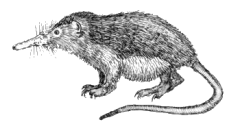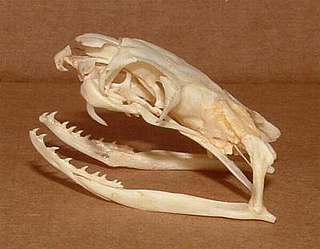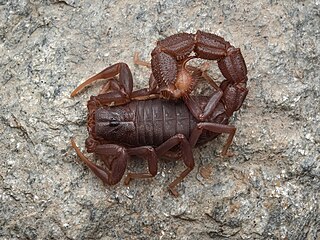
A toxin is a naturally occurring organic poison produced by metabolic activities of living cells or organisms. They occur especially as proteins, often conjugated. The term was first used by organic chemist Ludwig Brieger (1849–1919) and is derived from the word "toxic".

Venom or zootoxin is a type of toxin produced by an animal that is actively delivered through a wound by means of a bite, sting, or similar action. The toxin is delivered through a specially evolved venom apparatus, such as fangs or a stinger, in a process called envenomation. Venom is often distinguished from poison, which is a toxin that is passively delivered by being ingested, inhaled, or absorbed through the skin, and toxungen, which is actively transferred to the external surface of another animal via a physical delivery mechanism.

Batrachotoxin (BTX) is an extremely potent cardio- and neurotoxic steroidal alkaloid found in certain species of beetles, birds, and frogs. The name is from the Greek word βάτ�span>bátrachos, 'frog'. Structurally-related chemical compounds are often referred to collectively as batrachotoxins. In certain frogs, this alkaloid is present mostly on the skin. Such frogs are among those used for poisoning darts. Batrachotoxin binds to and irreversibly opens the sodium channels of nerve cells and prevents them from closing, resulting in paralysis and death. No antidote is known.
Bufagin is a toxic steroid C24H34O5 obtained from toad's milk, the poisonous secretion of a skin gland on the back of the neck of a large toad (Rhinella marina, synonym Bufo marinus, the cane toad). The toad produces this secretion when it is injured, scared or provoked. Bufagin resembles chemical substances from digitalis in physiological activity and chemical structure.

The Colorado River toad, also known as the Sonoran Desert toad, is a toad species found in northwestern Mexico and the southwestern United States. It is well known for its ability to exude toxins from glands within its skin that have psychoactive properties.

A ”spitting” cobra is any of several species of cobra that can intentionally, defensively shoot their venom directly from their fangs. This substance has two functions, with the first being as venom that can be absorbed via the victim’s eyes, mouth, or nose, and secondly as a toxungen, which can be sprayed on the target surface. Their ability to target and shoot venom is utilised in several different ways, self-defense being the most common instance. Studies have shown that the targets are far from random; rather, spitting cobras consciously take aim, directing their spray as close as possible to the eyes and face of an aggressor.

Samandarin or Samandarine is the main steroidal alkaloid secreted by the fire salamander (Salamandra salamandra). The compound is extremely toxic (LD50 = 70 µg/kg in mice). Poisoning can cause convulsions, respiratory paralysis, and eventual death. Samandarin is also believed to be the active ingredient in Salamander brandy, a Slovenian drink with purported hallucinogenic and aphrodisiac effects.

Venomous mammals are animals of the class Mammalia that produce venom, which they use to kill or disable prey, to defend themselves from predators or conspecifics or in agonistic encounters. Mammalian venoms form a heterogeneous group with different compositions and modes of action, from three orders of mammals: Eulipotyphla, Monotremata, and Chiroptera. It has been proposed that some members of a fourth order, Primates, are venomous. To explain the rarity of venom delivery in Mammalia, Mark Dufton of the University of Strathclyde has suggested that modern mammalian predators do not need venom because they are able to kill quickly with their teeth or claws, whereas venom, no matter how sophisticated, requires time to disable prey.

Toxicofera is a proposed clade of scaled reptiles (squamates) that includes the Serpentes (snakes), Anguimorpha and Iguania. Toxicofera contains about 4,600 species, of extant Squamata. It encompasses all venomous reptile species, as well as numerous related non-venomous species. There is little morphological evidence to support this grouping; however, it has been recovered by all molecular analyses as of 2012.
A latrotoxin is a high-molecular mass neurotoxin found in the venom of spiders of the genus Latrodectus as well as at least one species of another genus in the same family, Steatoda nobilis. Latrotoxins are the main active components of the venom and are responsible for the symptoms of latrodectism.

Rhabdophis subminiatus, commonly called the red-necked keelback or red-necked keelback snake, is a species of venomous snake in the subfamily Natricinae of the family Colubridae. The species is endemic to Asia.

Venomous snakes are species of the suborder Serpentes that are capable of producing venom, which they use for killing prey, for defense, and to assist with digestion of their prey. The venom is typically delivered by injection using hollow or grooved fangs, although some venomous snakes lack well-developed fangs. Common venomous snakes include the families Elapidae, Viperidae, Atractaspididae, and some of the Colubridae. The toxicity of venom is mainly indicated by murine LD50, while multiple factors are considered to judge the potential danger to humans. Other important factors for risk assessment include the likelihood that a snake will bite, the quantity of venom delivered with the bite, the efficiency of the delivery mechanism, and the location of a bite on the body of the victim. Snake venom may have both neurotoxic and hemotoxic properties. There are about 600 venomous snake species in the world.

Parabuthus transvaalicus is a species of venomous scorpion from semi-arid parts of southern Africa.
Tityustoxin is a toxin found in the venom of scorpions from the subfamily Tityinae. By binding to voltage-dependent sodium ion channels and potassium channels, they cause sialorrhea, lacrimation and rhinorrhea.

The Duvernoy's gland is a gland found in some groups of colubrid snakes. It is distinguished from the venom gland and is not found in viperids or elapids. It was named for French zoologist Georges Louis Duvernoy who first described the gland in 1832.
Birtoxin is a neurotoxin from the venom of the South African Spitting scorpion. By changing sodium channel activation, the toxin promotes spontaneous and repetitive firing much like pyrethroid insecticides do
Bestoxin is a neurotoxin from the venom of the South African spitting scorpion Parabuthus transvaalicus. Most likely, it targets sodium channel function, thus promoting spontaneous and repetitive neuronal firing. Following injection into mice, it causes non-lethal writhing behaviour.
Altitoxin is a neurotoxin found in the South African scorpion Parabuthus transvaalicus. Injection of altitoxin in mice leads to akinesia, depression and death.
Ikitoxin is a neurotoxin from the venom of the South African Spitting scorpion that targets voltage-sensitive sodium channels. It causes unprovoked jumps in mice following intracerebroventricular injections.
Polymorphic toxins (PTs) are multi-domain proteins primarily involved in competition between bacteria but also involved in pathogenesis when injected in eukaryotic cells. They are found in all major bacterial clades.












